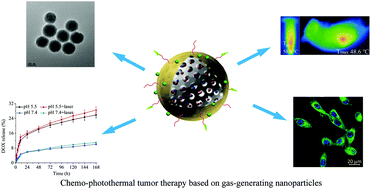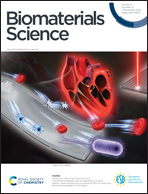Gas-generating mesoporous silica nanoparticles with rapid localized drug release for enhanced chemophotothermal tumor therapy†
Abstract
Chemophotothermal combination therapy has emerged as a novel and promising strategy to treat cancer. To improve anticancer effectiveness and reduce systemic toxicity, it is essential to trigger drug release at tumor sites or within tumor cells for maximal drug exposure. Herein, we constructed gas-generating mesoporous silica nanoparticles (MSNs) that can load ammonium bicarbonate (ABC) and doxorubicin (DOX) within the pores, encapsulate indocyanine green (ICG) onto the polydopamine (PDA) layer, and modify the RGD peptide on the outer surface [denoted as M(abc)-DOX@PDA-ICG-PEG-RGD] for triggered drug release and targeted chemophotothermal combination therapy. Upon hyperthermia or low pH value, the encapsulated ABC can efficiently generate CO2 gas, thus enhancing the damage to the PDA layer and accelerating DOX release. In vitro experiments showed that the M(abc)-DOX@PDA-ICG-PEG-RGD significantly enhanced cellular uptake and cytotoxicity, and laser irradiation further increased the endocytic and cytotoxic effects. An in vivo study indicated that the nanoparticles can effectively accumulate at the tumor site and significantly inhibited tumor growth with no side-effects to the normal organs. Thus, this gas-generating MSN-based nanocarrier that can trigger drug release in response to laser irradiation or low pH value holds great potential in enhancing cancer chemophotothermal combination therapy.



 Please wait while we load your content...
Please wait while we load your content...